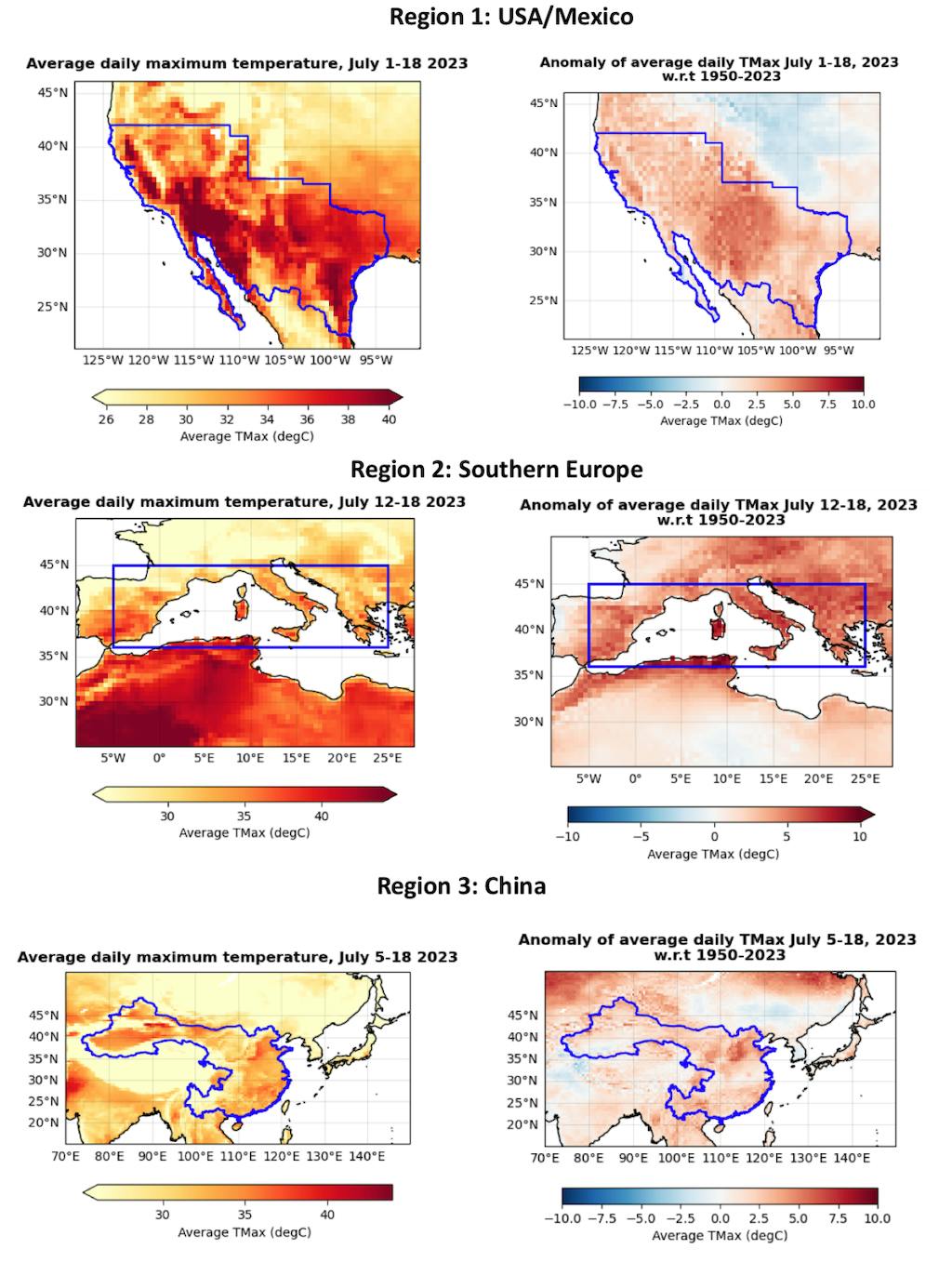July 2023 has seen unprecedented heat affecting much of the northern hemisphere, causing temperature records to tumble.
China’s national temperature record was shattered on 16 July when the mercury reached 52.2C.
Meanwhile, nearly one-third of the US population were put under heat warnings earlier in the month as a “historic” heatwave set multiple heat records of above 100F (37.8C).
And hospital cases across southern Europe have soared as the region swelters under the “Cerberus” heatwave.
The World Weather Attribution service – a global network of scientists who investigate the influence of climate change on extreme weather events – finds that the heatwaves in the US and Europe would have been “virtually impossible” in a world without climate change.
The heatwave in China was “at least 50 times more likely” due to climate change, it adds.
The warming effect of El Niño – a natural cycle of climate variability – “likely contributed some additional heat to the heatwaves in some regions”, the study finds. But, during a press briefing, an author on the study explained that its impact is “very small compared to the effect of climate change”.
The study finds that if average global temperatures reach 2C above preindustrial temperatures – a 0.8C increase from today – extreme heat events on this scale could happen every 2-5 years.
Records topple
The first week of July 2023 was the Earth’s hottest on record. Across the planet, people are still battling with the impacts of extreme heat as temperature records continue to topple.
Extreme weather events across the globe this month have already featured on more than 114 frontpages in at least 84 newspapers, published across 32 countries, Carbon Brief analysis shows.
In the US, nearly one-third of the country’s population were put under excessive-heat advisories, watches or warnings as a “historic” heatwave set multiple heat records of above 100F (37.8C).
Temperatures at Furnace Creek in California’s Death Valley, which holds the record for the hottest place on Earth, hit 53.3C on 16 July, approaching the all-time high of 56.7C in July 1913. And, on 19 July, the city of Phoenix, recorded a peak temperature of at least 110F (43.3C) for the 20th day in a row – extending a record that had been broken the day before.
Across the Atlantic, southern Europe suffered through the “Cerberus” heatwave, which saw temperatures rise up to 10C above average, quickly followed by the “Charon” heatwave.
Temperatures topped 40C in parts of Spain, France, Italy, Greece and Bosnia, while Sicily saw temperatures as high as 115 degrees (46.3 C).
In Rome, a new record high temperature of 41.8C was recorded on 18 July. Most major cities in Italy were placed on “red alert” due to the intense heat, with forecasters reporting that parts of the Italian islands of Sardinia and Sicily could reach highs of 49C.
And China recorded its highest ever temperature on 16 July when the remote Sanbao township in the Turpan depression of Xinjiang saw temperatures climb to 52.2C. This broke the previous record of 50.3C, measured in 2015.
Meanwhile, Beijing topped its record for high-temperature days in a year on 18 July, which marked 27 days above 35C.
Mapped
To investigate the exceptional heat that has swept across much of the northern hemisphere over the past month, the World Weather Attribution service focuses on three separate regions and time periods where “anomalously high temperatures” were reported and many people have been affected by the heat.
These are the western US and Mexico over 1-18 July, southern Europe over 12-18 July and China over 5-18 July.
Dr Frederieke Otto is a senior lecturer in climate science at the Grantham Institute for Climate Change and the Environment at Imperial College London and co-author of the study. (Otto is also a Carbon Brief contributing editor.)
She told a press briefing that different time spans were chosen for different regions to reflect when the heatwaves had the greatest impact on people. However, she said that the final results of the study were “not very sensitive” to the exact event definition.
The maps below show the average maximum temperatures (left) and difference compared to the 1950-2023 average (right) for the three regions and time periods chosen. Darker reds indicate hotter temperatures.

Average maximum temperatures (left) and difference compared to the 1950-2023 average (right) for the US (top), Europe (middle) and China (bottom), using ERA5 data. Source: WWA (2023).
The warming effect of El Niño – a natural cycle of climate variability – “likely contributed some additional heat to the heatwaves in some regions,” the study finds. But Otto told the press briefing that its impact is “very small compared to the effect of climate change”.
Attribution
Attribution is a fast-growing field of climate science that aims to identify the “fingerprint” of climate change on extreme-weather events, such as heatwaves and droughts. In this study, the authors investigated the impact of climate change on extreme heat over the three study regions.
To conduct attribution studies, scientists use models to compare the world as it is today – in which global average temperatures have risen by 1.2C thanks to human activity – to a “counterfactual” world without human-caused climate change.
This study aimed to distinguish the “signal” of climate change in the 18-day, 7-day and 14-day heatwaves defined in the US, Europe and China, respectively.
The US and Europe would have been “virtually impossible” in a world without climate change, the study finds. It adds that the heatwave in China was “at least 50 times more likely” due to climate change.
The July 2023 heatwaves in the US, Europe and China were also 2C, 2.5C and 1C hotter, respectively, than they would have been in a world without climate change, the authors find.
“These events are not rare anymore today,” the authors warn. In today’s climate, the extreme heat seen in the US, southern Europe and China can be expected once every 15, 10 and 5 years respectively.
The authors also warn that if global temperatures reach 2C above preindustrial temperatures – an increase of 0.8C from global average temperatures in today’s climate – extreme heat events on the scale of those in July 2023 could happen every 2-5 years.
(The authors started work on this study on 18 July. These findings are yet to be published in a peer-reviewed journal. However, the methods used in the analysis have been published in previous attribution studies.)
Heat preparedness
For decades, climate scientists have been predicting a rise in the intensity and frequency of extreme heat events. As such, Otto told the press briefing that the findings of this study are “absolutely not a surprise”, noting that we are seeing “exactly what has been projected in the past”.
However, she added that our societies and ecosystems are “much more vulnerable” to the changes in temperature than previously thought.
Heatwaves are “amongst the deadliest natural hazards that we face each year,” Julie Arrighi from the Red Cross Red Crescent Climate Centre told the press briefing. She emphasised the importance of “health action plans”, pointing out some measures that some countries are currently taking to limit the impact of high temperatures.
For example, she explained Italian hospitals reported a spike in admissions during the heatwave and the government activated a heat code to fast track patient access to emergency rooms.
Meanwhile, she said that power consumption “increased substantially” in many urban centres in China. But power outages remained “very limited” after measures including emergency generators and extra staff were rolled out.
She stressed that it is “vital to address the rising risks from heat”. In the short term, this involves implementing heat action plans and warning systems, she said, while, in the long term, the world needs to adapt “critical systems”, such as health, electricity and urban planning.








